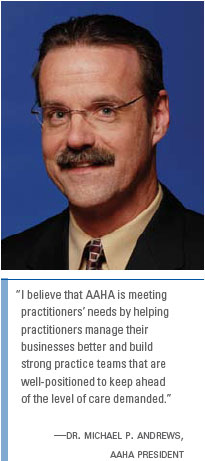Once a vet tech, now AAHA president
|
Prior to graduating from Purdue University School of Veterinary Medicine in 1983, Dr. Andrews worked as a certified veterinary technician. Never before has a former veterinary technician served as AAHA president. Dr. Andrews completed a degree in veterinary technology from the State University of New York at Delhi in 1975. He then worked at a laboratory animal breeding facility in the Midwest and later held a technician job in the summers between veterinary school semesters. After graduating from Purdue, Dr. Andrews completed a small animal medicine internship at the University of Guelph, Ontario Veterinary College. He has practiced small animal medicine in California for more than two decades and has owned Woodcrest Veterinary Clinic in Riverside since 1992. Dr. Andrews has been active in organized veterinary medicine longer than he's been a veterinarian, starting with his participation in the student chapter of the AVMA at Purdue. For him, it's a way of giving back to the profession. "I definitely have a true understanding of the challenges facing various members of the practice team," Dr. Andrews said. "I look forward to contributing to the further rise of our profession and the roles of all members of the veterinary practice team." Dr. Andrews joined the AAHA board of directors in 2000 and has served as vice president and president-elect. He was the AAHA delegate to the AVMA House of Delegates and a member of the National Commission on Veterinary Economic Issues. In addition, Dr. Andrews is a past president of the California VMA and Orange Belt VMA. He represented California in the AVMA HOD and is a past chairman of the AVMA Committee on Veterinary Technician Education and Activities. Dr. Andrews is also an accomplished mountaineer and has climbed many of the world's highest peaks, including Mount Kilimanjaro, Mount Shasta, Mount Rainier, Mount McKinley, and most recently, Mount Aconcagua. He hopes to one day summit Mount Everest. As president of the 36,000-member-strong AAHA, Dr. Andrews wants to make the association's board of directors the best decision-making body possible. "That means educating board members, utilizing them effectively, making them comfortable, helping them do the best job they can, and giving them an opportunity to hear the many voices in our diverse profession," he said. More than 3,500 people turned out for the conference, including 1,365 veterinarians; 315 practice managers; 630 technicians, assistants, and support staff; and 105 students and other professionals. One of the AAHA's latest endeavors is creation of diagnostic codes for companion animal practice. Testing of the 2,000 diagnostic codes and 2,000 "clinical symptom" codes got under way this spring. The hope is the codes, based on the SNOMED—Systematized Nomenclature of Medicine—system, will provide rapid measurement of client compliance in private practices and facilitation of disease incidence surveillance in pets. The AAHA anticipates making the codes available to vendors of practice management software systems and encouraging them to integrate the codes into their systems. The association also anticipates offering the codes to practices using their own proprietary management software for similar incorporation. The project is tentatively scheduled for finalization late this year or early 2007. The AAHA is working with the American Association of Feline Practitioners on pain management guidelines for cats, Dr. Andrews noted. As for the most pressing issues facing the veterinary profession, Dr. Andrews said, "For most practices, the biggest issue is keeping up with the public's demands. Pet owners demand the best quality of practice, services, and treatment modalities. As a profession, we need to meet these demands while running efficient practices. We need to be good business stewards so that we can offer cutting-edge techniques, and (we need to) provide appropriate compensation so we have the best staff. "I believe that AAHA is meeting practitioners' needs by helping practitioners manage their businesses better and build strong practice teams that are well-positioned to keep ahead of the level of care demanded." | ||
 The American Animal Hospital Association marked a milestone when Dr. Michael P. Andrews assumed the association's presidency following its annual conference this March in Long Beach, Calif.
The American Animal Hospital Association marked a milestone when Dr. Michael P. Andrews assumed the association's presidency following its annual conference this March in Long Beach, Calif.